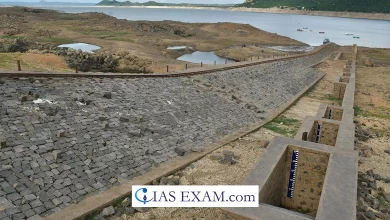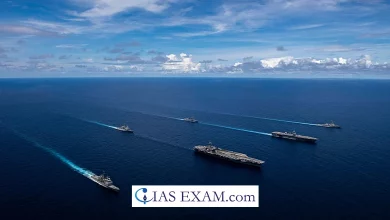Bay of Bengal and its Stressed Ecology
[GS Paper 3 – Environmental Pollution, Degradation and Conservation]
Context – The Indian PM Narendra Modi had announced the opening of the Centre for Bay of Bengal Studies (CBS) at the Nalanda University during the fourth BIMSTEC Summit.
With this announcement, India had once again reiterated its commitment towards advancing constructive agenda by forging connections and setting up platforms for all those having stakes in the Bay of Bengal.
Importance of Bay of Bengal
- In the Indian Ocean, the Bay of Bengal has become a major commerce hub and has been able to create a conduit between the East and West in terms of trade and culture.
- The realignment of global economic and military power added with the Indo-Pacific orientation is having a considerable impact in the Bay of Bengal region.
- The lifelines for global economic security are the key sea lanes of communication in this area and are very crucial for powers of the economies of many countries in this region and their energy security. Other non-traditional dangers like terrorism and climate change change have become more prevalent in these times.
- An opportunity for greater regional cooperation in the environmentally friendly exploration of marine and energy resources is also provided by the Bay of Bengal while it also possesses a biodiverse marine environment.
- The Bay of Bengal receives freshwater from some of the world’s largest river systems and has given rise several geological characteristics owing to it being a partially enclosed sea.
- Numerous rare and endangered marine species and mangroves are endemic to the Bay of Bengal which are essential to the survival of the ecology and the fishing sector.
Why is Ecology in BOB under threat?
The Maritime environment of the Bay of Bengal is changing rapidly as a result of the expansion of economic and geopolitical influence by major powers.
- Economic competition along with political and cultural engagement have taken on new dimensions. More importantly, the Bay of Bengal’s ecosystem is currently going through an unprecedented crisis due to widespread environmental exploitation and geopolitical unrest.
- Species Extinction has severe consequences on biodiversity and is a result of reckless exploitation of the maritime environment. The issues including population growth, altered land use, excessive resource exploitation, salinity and sea rise level and climate change are exerting considerable strain on the Bay of Bengal’s environment.
- The deterioration of the Bay of Bengal is increased many folds by certain actions and activities including – operational discharge from small and medium feeder ships, shipping accidents, oil spills, industrial waste, pollution, accumulation of non-biodegradable plastic matter etc.
- The Mangrove Forests are like the jewels of the Bay of Bengal. But over the years, a dead-zone has been formed owing to which the mangrove trees that protect the shores from the fury of nature are under more threat than ever.
Possible Measures and Solutions
- More focused and inter-disciplinary study is required on the issues of these regions for a better knowledge of the challenges and discovering strategies to overcome them for the sustainable development of the region.
- With the foundation of Centre for Bay of Bengal Studies (CBS), the Nalanda University has already started the journey and provided the nation with a unique research centre dedicated to the focused teaching, research and capacity building of the Bay of Bengal.
- It is highly essential that nautical neighbors develop a partnership and cooperate because of the maritime domain’s interrelated and interdependent nature, transnational character and cross-jurisdictional engagement of various governments and diverse organizations.
- There are few other concerns that require immediate attention including expansion of cooperation in maritime safety and security, enhancing cooperation and maritime connectivity and the ease of maritime transit while also boosting the possibilities of investment in the maritime connectivity sector.
- The illegal activities need to be addressed involving non-traditional threats and fostering group efforts to reduce illicit , unreported and unregulated fishing.
- Going further, regional maritime entities should strive to balance opportunities and goals on a national, regional and global scale. All the littoral countries and their governments should support and promote skill-building, research and training.
Conclusion
The nations in and around the Bay of Bengal region need to mobilize their investments and manage maritime affairs more effectively. Alternatives should be explored for all related spheres. The most crucial aspect in protecting the ecology of Bay of Bengal is the cooperation of all member states for information gathering, sharing and result-oriented actions.





.png)



